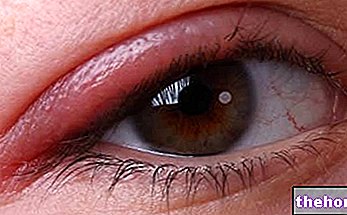Definition
From the Greek spondilo (vertebra) e olisthesis (slipping), spondylolisthesis delineates a painful pathological condition in which one vertebral portion (or the entire vertebra) slides over another, posteriorly, laterally or anteriorly. Anterior sliding (anteriolisthesis) is observed in the majority of diagnosed patients, affecting the 4th and 5th lumbar vertebrae.
Causes
Spondylolisthesis is often the expression of a congenital malformation or an acute and sudden trauma. In adults, spondylolisthesis is often favored by rheumatoid arthritis or other degenerative diseases: in similar situations, slipping between the fourth and fifth lumbar vertebrae is often observed.
- Risk factors: traumatic (weight lifting) fractures, stress fractures, bone pathologies
Symptoms
The symptom picture of spondylolisthesis varies a lot: some patients do not complain of any symptoms, while for others the disorder is very painful. Among the most recurrent symptoms, we find: pain in the thighs and buttocks, lower back pain, muscle stiffness and tension in the affected area. The weakness of the lower limbs and the hypersensitivity that accompanies the disorder often derive from the pressure exerted on the nerves, also responsible for pain that gradually radiates into all the legs.
The information on Spondylolisthesis - Drugs to Treat Spondylolisthesis is not intended to replace the direct relationship between health professional and patient. Always consult your doctor and / or specialist before taking Spondylolisthesis - Medicines to Treat Spondylolisthesis.
Medicines
Treatment aimed at treating spondylolisthesis is subject to the severity of the underlying pathological condition; many patients benefit from simply practicing specific stretching exercises and rehabilitation techniques associated with small lifestyle changes (eg correct posture). In case of spondylolisthesis, symptomatic or not, it is recommended to avoid practicing extreme sports exercises or exercises that could aggravate pain and lumbar arching (lumbar hyperlordosis). It is particularly useful to strengthen the abdominal muscles and the stabilizing muscles of the pelvis, in addition to following a stretching path for the spinal muscles.
In the event that physical exercises do not bring any benefit, it is possible to proceed with secondary interventions, leaving surgery as a last resort: in the symptomatic forms of spondylolisthesis, the administration of NSAIDs, therefore non-steroidal anti-inflammatory drugs, is particularly effective for control Some patients benefit from wearing a rigid brace.
The surgery, as mentioned, is reserved exclusively for extreme cases, in which spondylolisthesis creates acute pain and heavily affects the quality of life of the patient who is affected by it: the intervention aims to align the vertebra - slipped forward - with the one below.
The following are the classes of drugs most used in therapy against spIondylolisthesis, and some examples of pharmacological specialties; it is up to the doctor to choose the most suitable active ingredient and dosage for the patient, based on the severity of the disease, the state of health of the patient and his response to treatment:
- Heptotermin alfa (eg Opgenra, Osigraft): this is a drug widely used in therapy for the treatment of severe forms of spondylolisthesis, especially inoperable ones. The active ingredient is also used following a targeted surgery (autologous graft surgery), which did not report any beneficial effect to the patient. The active ingredient is an analogue of the bone morphogenic protein 7 (BMP-7), a "very important protein involved in the complex mechanism of bone reformation": this drug is therefore indicated to favor the fusion between two vertebrae in patients suffering from spondylolisthesis, previously operated without success. The use of the drug is exclusively of medical competence; the active ingredient is formulated as a powder, to be subsequently combined with the carmellose drug, to prepare a pasty suspension to be implanted (the drug must be applied on the sides of the affected vertebrae, to stimulate growth again bone tissue that will be used for the fusion of the same).
Non-steroidal anti-inflammatory drugs for pain control: The administration of these drugs is NOT useful for healing from spondylolisthesis, but to temporarily cover the pain.
- Ibuprofen (eg. Brufen, Moment, Subitene): for medium-moderate pain, it is recommended to take by mouth a dose of active equal to 200-400 mg (tablets, effervescent sachets) every 4-6 hours after meals, at need. Do not take more than 2.4 grams per day.
- Naproxen (eg Aleve, Naprosyn, Prexan, Naprius): it is recommended to take the drug at a dosage of 550 mg, orally, once a day, followed by 550 mg of active ingredient every 12 hours; alternatively, take 275 mg of naproxen every 6-8 hours, as needed. Do not exceed 1,100 mg per day.
- Acetylsalicylic acid (eg Aspirin, Vivin, Ac Acet, Carin): the drug, indicated for adults only, should be taken at a dosage of 325-650 mg orally or rectally, every 4 hours, as needed. Do not exceed 4 grams per day. In case of osteoarthritis associated with spondylolisthesis, it is possible to take 3 grams per day of the drug, possibly dividing the load into several doses. Giving the drug to children under the age of 12 can cause serious side effects, such as Reye's syndrome, liver dysfunction and brain changes.
- Codeine (eg Codein, Hederix Plan): this is a narcotic drug used when the previously described NSAIDs do not exert their therapeutic effect, due to too intense pain. As an indication, take a drug dose of 30 mg, orally, intramuscularly or intravenously, every 6 hours, as needed. In some patients, it is necessary to increase the dose to 60 mg every 4 hours. Don't abuse. Follow the instructions prescribed by the doctor.
Steroid drugs for pain: thanks to their powerful anti-inflammatory effect, corticosteroids are also used to control painful symptoms and inflammation that accompanies spondylolisthesis. They can be taken orally or injected directly on site.
- Prednisone (eg. Deltacortene, Lodotra): take 5-60 mg of active orally in 1-4 divided doses over 24 hours. Consult your doctor. Do not continue therapy beyond what is necessary.
- Methylprednisolone (eg Advantan, Solu-medrol, Depo-Medrol, Medrol, Urbason): to ensure a moderate anti-inflammatory effect, take 4-48 mg per day of the drug orally. Consult your doctor.
It should be noted that the intake of steroid drugs, even in the context of spondylolisthesis, must always be established by the doctor and must never be abruptly stopped on one's own initiative.




























